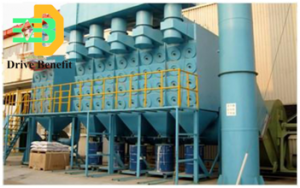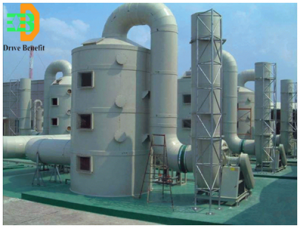Nowadays, industrial dust removal equipment is not only used in industry, but also widely used in professions such as medicine, food, and electronics. The dust collector provided by Debo in the pharmaceutical industry generates a lot of dust, wastewater, and exhaust gas in the production of professions such as medicine and food. Therefore, industrial dust removal equipment has become an indispensable equipment in professions such as medicine.

The current situation of the pharmaceutical profession:
With the increasingly perfect pharmaceutical industry in China, the pharmaceutical industry has achieved rapid development. Although the economic benefits of developing the pharmaceutical profession in the early stages are highly favored due to its high economic benefits, the pharmaceutical profession has faced difficulties in recent years. Especially for the GMP level requirements in the pharmaceutical industry, an important audit item and objective is the cleaning target. Due to its special function, industrial dust collectors have become an indispensable production machinery equipment in pharmaceutical production companies.
The use of dust collectors in the pharmaceutical industry:
In the production process of pharmaceuticals, tablet presses, capsule filling machines, counting machines, mixing machines, and crushers are used, resulting in a lot of dust and wastewater during the operation. If dust removal and purification are not carried out, the company will not be able to complete various inspection projects and cleaning goals, and will face the possibility of production stoppage or reorganization. Nowadays, industrial dust collectors are used to connect with pharmaceutical equipment such as tablet presses, capsule filling machines, and counting machines through reserved interfaces to handle dust and powder generated during the pharmaceutical process. The use of industrial dust collectors in pharmaceutical workshops can help companies meet standards and recover some raw materials, achieving energy-saving goals. Therefore, industrial dust collectors have become indispensable in pharmaceutical production.
Adapt to the trend of the country:
Faced with the dual pressure of power shortage and environmental degradation in China, the country has proposed to establish a frugal and friendly society. The company is one of the members of society and should actively participate in the reduction of emissions through skills, and implement national policies and regulations with practical actions. The widespread use of industrial dust removal equipment in the pharmaceutical industry not only saves capital, but also reduces air pollution, which benefits the development of the pharmaceutical profession without any harm.

In the pharmaceutical industry, there is currently no suitable dust collector for this industry. The dust collector provided by Debo for the pharmaceutical industry perfectly fills the gap in the market!
How can we solve the general environmental issues in pharmaceutical factories?
The environmental protection issue of pharmaceutical factories has always been one of the concerns of the country, mainly due to the presence of bacteria, acid and alkali waste gases, and odors in the wastewater and exhaust gases generated during the pharmaceutical production process, which can cause significant pollution to the surrounding environment and cause huge harm to human health At present, the exhaust gas treatment methods for pharmaceutical factories include adsorption desorption treatment, catalytic combustion, double alkali method, low-temperature plasma+composite photocatalysis, condensation, biofilm method, pulse corona method, spray tower washing of acid and alkali exhaust gas, etc So what treatment methods can exhaust gas treatment equipment use to meet the standard emission standards?
Low temperature plasma and composite photocatalysis utilize the characteristics of high flow and low concentration organic waste gas generated in the production process of industries such as pharmaceuticals. The core is to first use low-temperature plasma to generate high-energy electrons, which can directly decompose harmful gases in the waste gas factor, enabling them to quickly form small molecular fragments and degrade into CO2, H2O, etc. Then, by utilizing the action of photocatalysis, various harmful gases that have not been fully degraded can be degraded, thus achieving a satisfactory comprehensive degradation effect on workshop production waste gas
Special photon technology is a high-efficiency new process developed for the production of various types of odors and odorous waste gases. The equipment has small size, small footprint, low energy consumption, and convenient self-control Use single-stage or multi-stage series and parallel connections according to the actual situation It can be applied to various occasions such as high concentration and deep treatment. It contains active free oxygen and high-energy photons, which have strong targeting for the degradation of various VOCs containing aldehydes, hydrogen sulfide, olefins, organic amines, benzene derivatives and other waste gases with a volume of 5000-80000 m3/h. The waste gas treatment rate can reach over 97% The new, safe, and low-cost characteristics of this technology have great potential in the industry and will be widely applied in the odor gas treatment industry.
The distribution process of the complete set of equipment for low-temperature plasma+composite photocatalysis purification of exhaust gas in pharmaceutical factories is as follows: first, the exhaust gas source → the exhaust gas enters the activated carbon device and reacts with H2S in the odorous gas SW type efficient deodorizer desulfurization → The exhaust gas enters the PM water vapor separator to remove moisture → It is decomposed in the plasma+photocatalytic reactor, ultimately generating carbon dioxide and water → The fan discharges the treated exhaust gas that meets the standards through the exhaust pipe
Low temperature plasma technology is a new technology for exhaust gas treatment developed in recent years. The principle of low-temperature plasma treatment for exhaust gas is that when the applied voltage reaches the voltage of gas discharge, the gas is broken down, producing a mixture of electrons, various ions, atoms, and free radicals inside Low temperature plasma degradation of pollutants can utilize the interaction of high-energy electrons, free radicals, and other active particles with pollutants in exhaust gas, allowing pollutant molecules to decompose in a very short period of time to achieve the goal of pollutant degradation
From the above, we can see that the low-temperature plasma+composite photocatalytic exhaust gas treatment equipment has no direct contact between the electrode and the exhaust gas, and there is no equipment corrosion problem. The equipment starts and stops very quickly, can be used as needed, has low gas resistance, and is suitable for high flow rate and large air volume exhaust gas treatment. In the low-temperature plasma generated by dielectric barrier discharge, the electron energy is high and can interact with almost all gas molecules. The process is relatively mature At present, the trend for exhaust gas treatment is in the future
Introduction to the use of pulse bag filter in pharmaceutical factories:
The dust present in the atmosphere includes dust generated by natural phenomena such as sand and pollen, as well as dust generated by human activities such as production and daily life, such as smoke powder and powder. The crushing, screening, and tablet pressing processes generated in pharmaceutical production are prone to generate a large amount of dust. Therefore, dust removal and prevention measures must be taken to strengthen labor protection, enhance safety production, and recover dust to ensure quality.
The working principle of the pulse bag filter in a pharmaceutical factory: Place the unit in an independent dust removal space, configure corresponding air ducts and vacuum hoods to connect with the dust collector. The dusty gas flows from the dust source through the vacuum hood into the box of the pulse dust collector. Due to inertia, the coarser dust particles in the gas fall into the ash hopper, and the finer dust enters the filtering type with the airflow upward. The dust is adsorbed on the outer surface of the bag, and the purified gas enters the upper box of the dust collector through the bag. The upper box is collected and discharged through the exhaust outlet,
As the amount of dust attached to the outer surface of the bag increases, the resistance to airflow also increases. When a certain resistance value is reached, the cleaning system automatically cleans the dust, causing the bag to suddenly expand and shake off the dust attached to the surface of the bag. The dust falls into the ash hopper under the action of gravity.
The advantage of this pulse dust collector in pharmaceutical factories is its high efficiency, which can reach over 99.95%. Dust collectors have strong adaptability, are very flexible to use, have stable working performance, and are very convenient for recycling materials. Therefore, pulse dust collectors are widely used in the pharmaceutical industry and are an efficient dust removal equipment.
